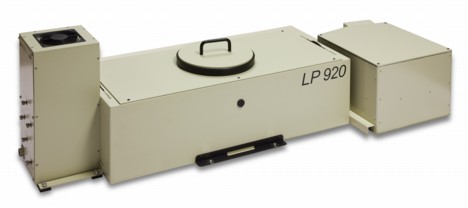Home > Press > Edinburgh Instruments’ Spectrometer Helps Identify New Electronic State In Carbon Nanotube Research
 |
Abstract:
Researchers at Duke University1 have utilised the LP920 laser flash photolysis spectrometer from Edinburgh Instruments to experimentally observe excited triplet states of individualised single-wall carbon nanotubes (SWNTs) for the first time. These SWNT triplet excitons have lifetimes of the order of microseconds, differing vastly the picosecond lifetimes characteristic of the well-known SWNT singlet excitons. This research provides new insights into the fundamental photophysical processes of 1-dimensional carbon-based nanostructures.
Edinburgh Instruments’ Spectrometer Helps Identify New Electronic State In Carbon Nanotube Research
Livingston, UK | Posted on March 8th, 2012SWNTs facilitate ballistic charge transport and fast singlet exciton migration over long distances; such properties are highly useful for electronic and photonic devices. The experimental identification of the SWNT triplet exciton state expands significantly the scope of nanotube electron and energy migration reactions that can be exploited.
Nanosecond pump-probe transient absorption spectroscopic experiments of purified, polymer wrapped SWNTs in a variety of solvents was carried out using the LP920 laser flash photolysis spectrometer equipped with the L900 software for control and data acquisition. A previously unidentified transient absorption band at 1150 nm is shown to correspond to a SWNT T1 to Tn transition; the lifetime of the SWNT triplet excited state was found to be 17.4 and 6.5 µs, respectively, in D2O and DMSO solvents.
In this study, (6,5)-chirality enriched semiconducting SWNTs that were helically wrapped by an aryleneethynylene polymer monolayer at periodic and constant morphology, were utilised. These polymer-wrapped SWNTs maintain uniform structural morphology in both D2O and DMSO solvents, and provide versatile constructs in which to probe nanotube triplet exciton states.
The LP920 laser flash photolysis spectrometer is a fully automated turnkey solution for the reliable and accurate measurement of transient absorption either in spectral and/or kinetic mode. It has a large sample chamber to house a variety of sample holders.
####
For more information, please click here
Contacts:
Press Enquiries:
In Press Public Relations Ltd
PO Box 24
Royston, Herts, SG8 6TT
Tel: +44 1763 262621
Internet: www.inpress.co.uk
Other Enquiries:
Edinburgh Instruments
Photonics Division
2 Bain Square, Kirkton Campus
Livingston, EH54 7DQ, UK
Tel: + 44 1506 425 300
Internet: www.edinburghphotonics.com
Copyright © Edinburgh Instruments Ltd.
If you have a comment, please Contact us.Issuers of news releases, not 7th Wave, Inc. or Nanotechnology Now, are solely responsible for the accuracy of the content.
| Related News Press |
News and information
![]() Researchers develop molecular qubits that communicate at telecom frequencies October 3rd, 2025
Researchers develop molecular qubits that communicate at telecom frequencies October 3rd, 2025
![]() Next-generation quantum communication October 3rd, 2025
Next-generation quantum communication October 3rd, 2025
![]() "Nanoreactor" cage uses visible light for catalytic and ultra-selective cross-cycloadditions October 3rd, 2025
"Nanoreactor" cage uses visible light for catalytic and ultra-selective cross-cycloadditions October 3rd, 2025
Nanotubes/Buckyballs/Fullerenes/Nanorods/Nanostrings
![]() Enhancing power factor of p- and n-type single-walled carbon nanotubes April 25th, 2025
Enhancing power factor of p- and n-type single-walled carbon nanotubes April 25th, 2025
![]() Chainmail-like material could be the future of armor: First 2D mechanically interlocked polymer exhibits exceptional flexibility and strength January 17th, 2025
Chainmail-like material could be the future of armor: First 2D mechanically interlocked polymer exhibits exceptional flexibility and strength January 17th, 2025
![]() Innovative biomimetic superhydrophobic coating combines repair and buffering properties for superior anti-erosion December 13th, 2024
Innovative biomimetic superhydrophobic coating combines repair and buffering properties for superior anti-erosion December 13th, 2024
Announcements
![]() Rice membrane extracts lithium from brines with greater speed, less waste October 3rd, 2025
Rice membrane extracts lithium from brines with greater speed, less waste October 3rd, 2025
![]() Researchers develop molecular qubits that communicate at telecom frequencies October 3rd, 2025
Researchers develop molecular qubits that communicate at telecom frequencies October 3rd, 2025
![]() Next-generation quantum communication October 3rd, 2025
Next-generation quantum communication October 3rd, 2025
![]() "Nanoreactor" cage uses visible light for catalytic and ultra-selective cross-cycloadditions October 3rd, 2025
"Nanoreactor" cage uses visible light for catalytic and ultra-selective cross-cycloadditions October 3rd, 2025
Tools
![]() Japan launches fully domestically produced quantum computer: Expo visitors to experience quantum computing firsthand August 8th, 2025
Japan launches fully domestically produced quantum computer: Expo visitors to experience quantum computing firsthand August 8th, 2025
![]() Rice researchers harness gravity to create low-cost device for rapid cell analysis February 28th, 2025
Rice researchers harness gravity to create low-cost device for rapid cell analysis February 28th, 2025
|
|
||
|
|
||
| The latest news from around the world, FREE | ||
|
|
||
|
|
||
| Premium Products | ||
|
|
||
|
Only the news you want to read!
Learn More |
||
|
|
||
|
Full-service, expert consulting
Learn More |
||
|
|
||








